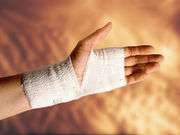Wrist fracture linked to higher subsequent fracture risk

(HealthDay)—For postmenopausal women, wrist fracture is associated with increased risk of subsequent non-wrist fracture, according to a study published in the November issue of the Journal of Bone and Mineral Research.
Carolyn J. Crandall, M.D., from the David Geffen School of Medicine at the University of California Los Angeles, and colleagues examined the frequency and type of fractures that occur after a wrist fracture among postmenopausal women. A post-hoc analysis of data from the Women's Health Initiative Observational Study and Clinical Trials was conducted. Participants, aged 50 to 79 years, were followed for a mean of 11.8 years.
The researchers found that 15.5 percent of the women who experienced wrist fracture subsequently experienced non-wrist fracture. Compared with those who had not experienced wrist fracture, women who had experienced previous wrist fracture had increased risk for non-wrist fracture (hazard ratios: 1.40 overall; 1.48 for spine; 1.78 for humerus; 1.88 for upper extremity; 1.36 for lower extremity; and 1.50 for hip). After adjustment for bone mineral density, physical activity, and other risk factures, the associations persisted. In women who were younger when they experienced wrist fracture, the risk of non-wrist fracture was higher (interaction P = 0.02).
"There may be substantial missed opportunity for intervention in the large number of women who present with wrist fractures," the authors write.
Two authors disclosed financial ties to Amgen.
More information:
Abstract
Full Text (subscription or payment may be required)
Copyright © 2015 HealthDay. All rights reserved.

















